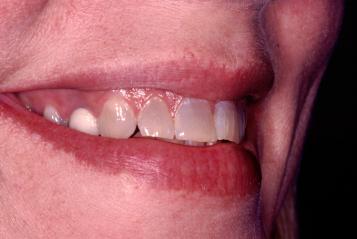Cosmetic dentistry gives the dentist the ability to mask tetracycline staining. Tetracycline, doxycycline, minocycline are types of antibiotic that are absorbed into developing teeth causing deep stains (tetracycline staining). If tetracycline is taken by someone during functional tooth development years (age 3-10), tetracycline stains are likely to occur. Permanent teeth start developing at around three years of age and continue into the teenage years (last teeth to erupt are the wisdom teeth).
Cosmetic dentistry gives the dentist the ability to mask tetracycline staining. Tetracycline, doxycycline, minocycline are types of antibiotic that are absorbed into developing teeth causing deep stains (tetracycline staining). If tetracycline is taken by someone during functional tooth development years (age 3-10), tetracycline stains are likely to occur. Permanent teeth start developing at around three years of age and continue into the teenage years (last teeth to erupt are the wisdom teeth).
Once the teeth erupt into the mouth, they are no longer susceptible to tetracycline staining. A teenager can take the antibiotic and not get tetracycline staining. This is not the case for a younger person with teeth developing inside the jaw. They will get permanent tetracycline staining. Because of this, the medical community has stopped prescribing tetracycline to children under the age of 10 years old or to pregnant women (whose developing baby can also be affected by tetracycline staining). The stains have no medical implications but are very unaesthetic. Tetracycline leaves behind a dark stain that can be either striated in nature or cover the entire tooth surface. Tetracycline stained teeth are usually brown or grayish in color.
When tetracycline was approved for human use, it was not known that tetracycline would permanently stain teeth in development. Tetracycline was developed as an alternative to Penicillin. Tetracycline is most often used to treat urinary tract infections, genital infections, acne, skin infections, and infections that cause stomach ulcers. The tetracycline became incorporated inside the developing teeth and left the teeth permanently dark in color.
Before the development of modern cosmetic dentistry there were few alternatives to cover this esthetically. Cosmetic dentistry has a few ways of dealing with this condition. These include teeth whitening and porcelain veneers.
Teeth Whitening and Tetracycline Staining
Teeth whitening can be very successful with tetracycline stained teeth when the staining is not very dark. Patients with minimal tetracycline staining on their teeth may have to continue to use the bleaching material daily for up to 6 months for noticeable results that will last. There are in office and at home whitening options in cosmetic dentistry for treating these stains. Over -the -counter type whitening will not be effective at all in teeth with tetracycline staining. The longer period of whitening at home can cause sensitivity and gum problems. This procedure needs to be closely monitored by the cosmetic dentist to ensure there is no damage to the enamel or gum tissue. In some cases of more severe tetracycline staining, teeth whitening is an insufficient treatment. This is due to how deeply embedded the staining is in the patient’s tooth enamel. Instead, porcelain veneers or dental bonding would be the standard approach to cover the remaining tetracycline staining after whitening procedures are complete.
Dental Bonding and Tetracycline Staining
Your cosmetic dentist may use dental bonding to cover the tetracycline staining that is present. By using dental bonding techniques your cosmetic dentist can mask the stains and create a new color as well as shape to your teeth. However, if the tetracycline stains are too deep and dark in the teeth, the staining may show through the dental bonding. This will create a lighter gray tooth rather than the bright, white teeth you may want. When this is the case, teeth whitening to remove as much of the tetracycline staining as possible, followed by dental bonding is a very good cosmetic dentistry treatment option.
Porcelain Veneers and Tetracycline Staining
Porcelain veneers are the best option we have in cosmetic dentistry for the treatment of tetracycline staining. Porcelain veneers are wafer thin and custom designed to reshape your teeth and color just the way you want it. With porcelain veneers,, we are able to adjust the opacity of the porcelain to allow the cosmetic dentist the ability to truly mask the tetracycline staining,(pre-whitening may still be necessary for the best overall result).
Thanks to cosmetic dentistry patients no longer have to suffer from tetracycline staining. Now these patients can fully smile just like everyone else without feeling self conscious. A smile can be the first thing people notice. With cosmetic dentistry’s many advances, you no longer have to settle for tetracycline stained teeth. You now have options that can help you smile full of self confidence.
© 2012, Marielaina Perrone DDS. All rights reserved. Las Vegas Cosmetic Dentist
